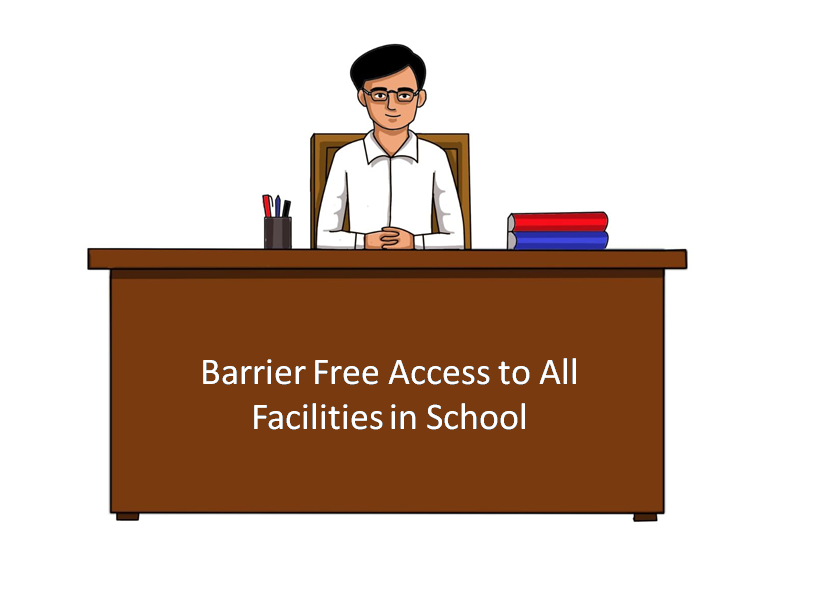
Barrier Free Access to All Facilities in School
“The goal of an inclusive education system is to provide all students with most appropriate learning environments and opportunities to best achieve their potentials” (Alberta Education 2010)
NEP 2020 vision-. A very first requirement in this direction will be to ensure decent and pleasant service conditions at schools. Adequate and safe infrastructure, including working toilets, clean drinking water, clean and attractive spaces conducive to learning, electricity, computing devices, and internet, library and sports and recreational resources will be important to provide to all schools in order to ensure that teachers and students including children of all genders and children with disabilities, receive a safe, non-violent, inclusive and effective learning environment and are comfortable and inspired to teach and learn in their schools. (5.9)
6.1 What is Barrier Free Access?
Barrier-free and sensory-friendly access refers to the design and organization of school environments in a way that allows all children—regardless of ability or disability—to fully access and benefit from every facility and service available in the school. This includes learning spaces, recreational areas, transportation, information systems, and support services.
According to UNICEF’s IE_Webinar_Booklet_10, accessibility is defined as:
“An enabler that allows children and adults with disabilities to enjoy their rights and entitlements. It is also a precondition for children and adults with disabilities to live independently and participate fully and actively.”
Barrier-free access goes beyond physical infrastructure. It encompasses the usability and availability of educational resources, learning materials, technology, internet access, assistive devices, and the overall school environment. The goal is to create a learning space where every student can thrive, participate, and reach their full potential without facing unnecessary barriers.
6.2 Why Improving Accessibility in Schools Matters
Accessibility is not a privilege—it is a fundamental part of the right to education. Unless schools are made accessible to all learners, especially those with disabilities, true inclusion remains out of reach.
Students with disabilities often face multiple barriers—physical, sensory, communicational, and attitudinal—that hinder their ability to participate in mainstream education. Improving school accessibility ensures that these barriers are identified and systematically removed.
Moreover, designing accessible schools is not just about buildings—it is a social responsibility and a driver of inclusive educational reform. It represents a shift towards a more equitable system where no child is left behind.
- School administrators must prioritize inclusive policies and infrastructure.
- Teachers and staff must be trained to support diverse learners.
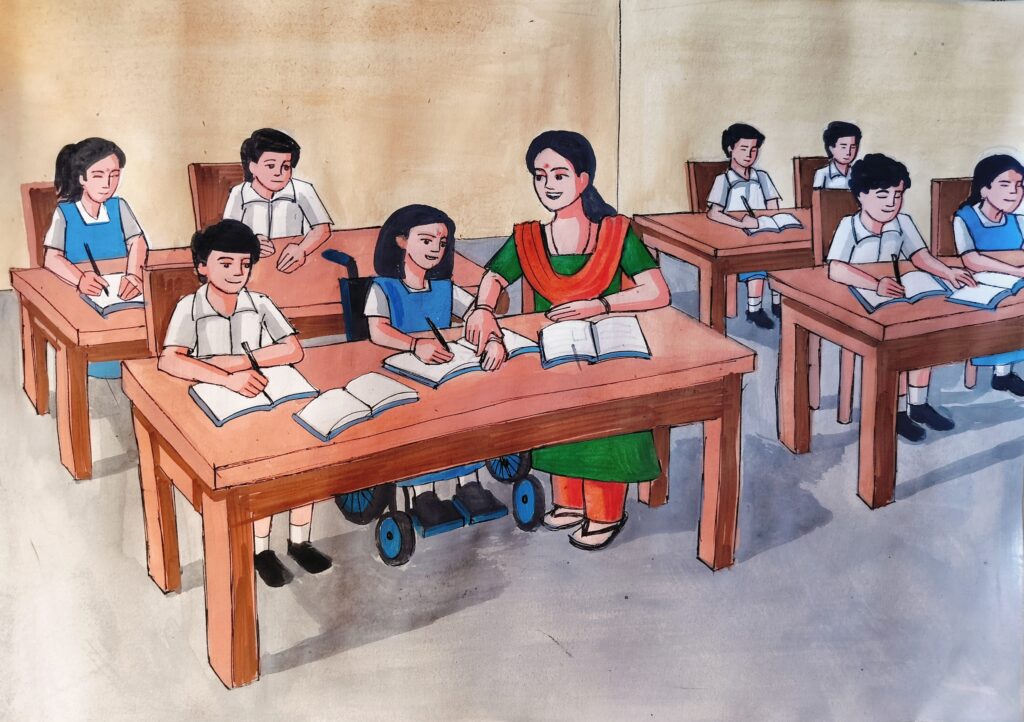
- Parents and caregivers must be included in decision-making and support systems.
- Students, both with and without disabilities, must be encouraged to embrace inclusion as a shared value.
Ultimately, improving accessibility is about building a school culture where diversity is respected, and every child can learn, participate, and succeed.
The Central Board of Secondary Education vide Circular No.05/2023, dated 06/3/2023 has re-iterated to all Heads and Managers of schools that the Board has incorporated in its Affiliation Byelaws 2018, under Rule No.4.7.3 that “the school shall provide proper facilities like, ramps in toilets and at entry/exit points for wheelchair users and auditory signals in elevators / lifts and other possible infrastructural facilities in accordance with the provisions laid down in RPWD Act 2016 “ and under Rule no. 14.5.2, “schools shall promote inclusion of students with special needs in the normal school as per provisions of the Rehabilitation of Persons with Disabilities Act- 2016 and in conformity with the National Policy of Education 2020.”
This circular provides clear and specific guidelines that schools need to follow, to provide barrier free access to all facilities and to all students.
6.3 Understanding Accessibility, Disability and Ability
Barriers exist in many forms within society, but children with disabilities face specific challenges that can prevent them from fully accessing education. These obstacles hinder their opportunity to grow into healthy, happy, and productive individuals. Such barriers effectively deny children their fundamental right to education.
As educators and responsible adults, it is our duty to ensure that every child—including those with disabilities—has equitable access to learning opportunities.
To establish an ideal barrier-free and sensory-friendly environment within schools, school authorities and owners must focus on key areas of transformation. Below are general recommendations and strategies that should be considered both when designing new school facilities and when renovating existing ones to remove accessibility barriers.
6.3.1 Academic Environment Accessibility
Focuses on inclusive access to learning spaces and academic tools.
Classrooms

Adaptations in classrooms cannot be generalised. They are tailor made to suit the needs of children in the respective classrooms. It can include-
- Movable furniture: Some work areas can have movable tables and seats to adapt to changing user needs and desks and tables with sufficient knee clearance for children who use wheelchairs.
- Adjustable-height seats and desks to accommodate students of different sizes and heights.
- Visual aids and flexible seating enable all children, with or without disabilities to learn with interest. Additional provisions to hang boards, charts etc at a lowered height will also help.
- Study carrels and Sensory tools: Carrels or small individual study spaces for focusing or working calmly. They help students with attention deficit or autism or anxiety. Sensory tools such as fidget items, noise cancelling headphones or weighted vests for sensory regulation help students in focusing.

- Clear walkways and reduced clutter: Staff must ensure that the classrooms are organized with clear pathways, labelled areas and minimized clutter to reduce distractions. They facilitate better learning

Libraries
In most schools, the libraries are not physically accessible to children with special needs. The experience of visiting a library, browsing through books from the shelves and making notes sitting in the library are all part of learning. The library can be made accessible by arranging for
- Wheelchair-accessible shelves
- Assistive technologies (screen readers, Braille books)
- Quiet zones and visual cues
Laboratories (Science, Computer, etc.) need to have certain adaptations in place so that children with special needs can also visit and experience the joy of learning by doing.
The following adaptations would be helpful:
- Adjustable-height workstations
- Adaptive input/output devices
- Tactile labels and accessible equipment
6.3.2 Physical Infrastructure Accessibility
Covers essential modifications to buildings and common areas for mobility and usability.
School Entrances and Pathways:The main school entrance should be easily identifiable from a distance by its design, location, signage, and lighting. It is important to ensure that students with disabilities can use the same entrance as other students. Providing a level-surfaced, well-maintained approach to the school makes the school a welcoming place. Therefore, wide pathways, ramps and doors which are easy to use should be provided.
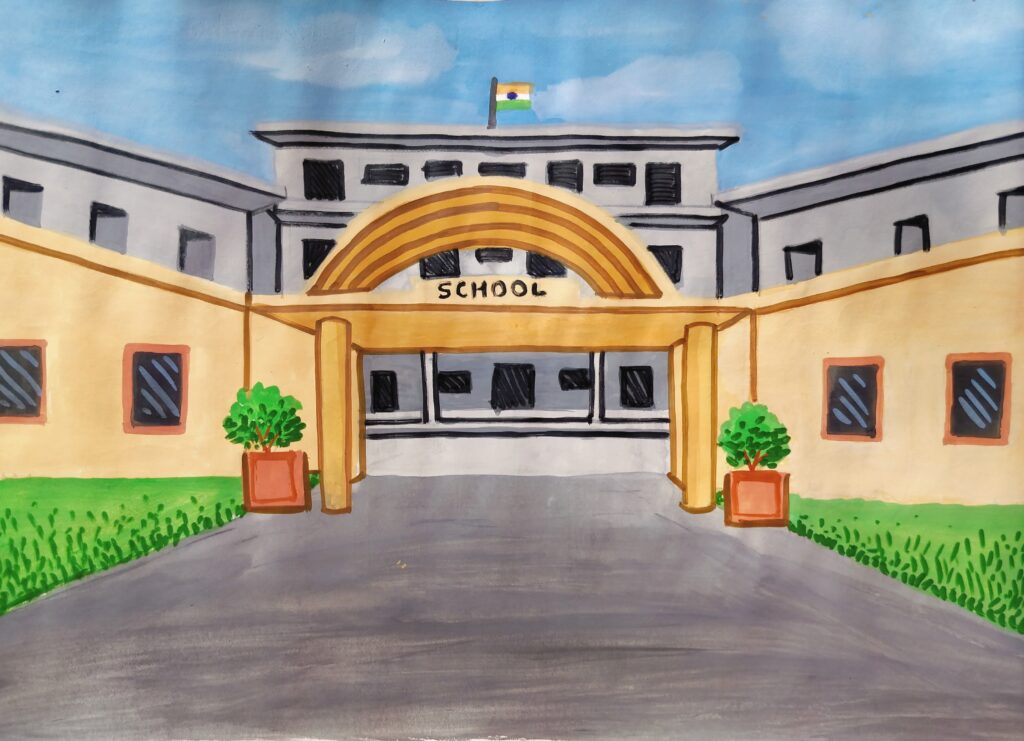
▪ Hallways, Corridors, and Stairs:
Anti-skid/slip and no/low-glare flooring is recommended throughout the school.

Stairs are used by many children with disabilities, including those who are visually impaired or who use crutches or canes to assist with walking. Accessibility features such as handrails on stairs make them safer for all building users, not just children with disabilities.
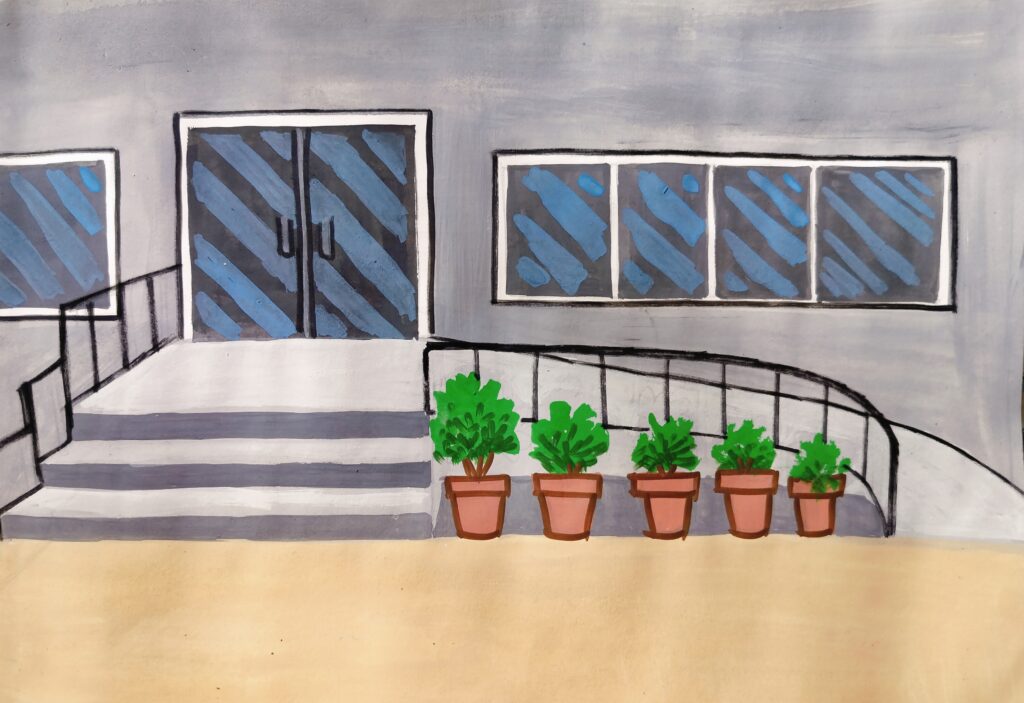
Colour/tonal contrast should be considered for both the front edges of the steps and the handrails, as well as tactile warning pavers used before the step edges.
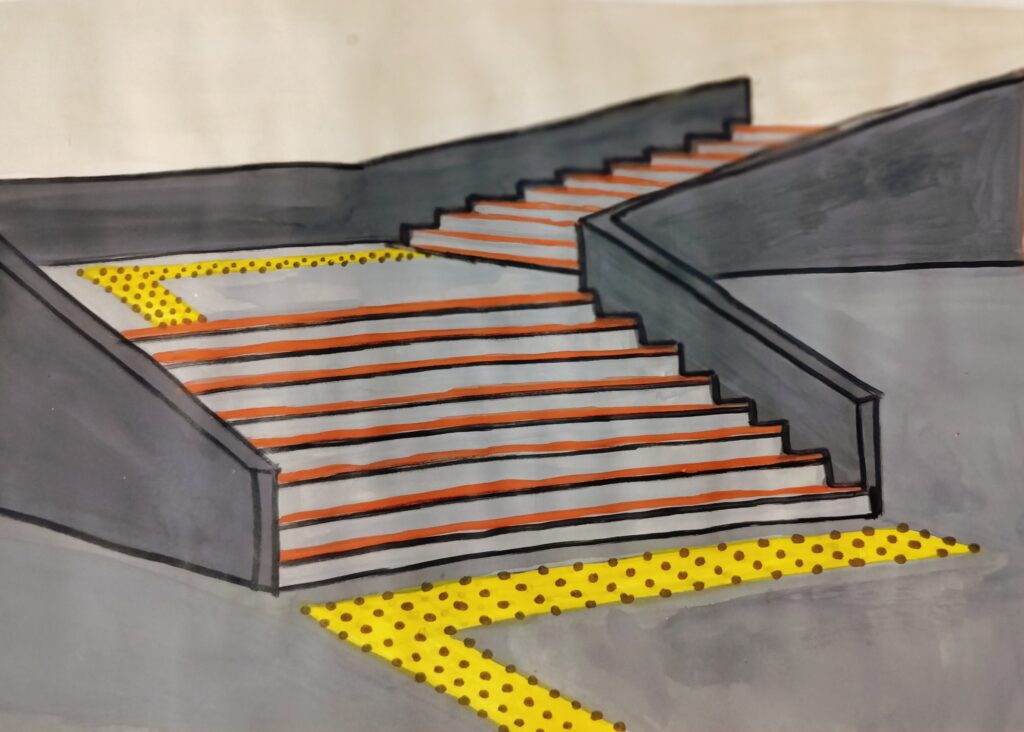
Spiral and stairs with tapered treads should be avoided. Slopes and ramps should be wide, smooth and safe with railings.
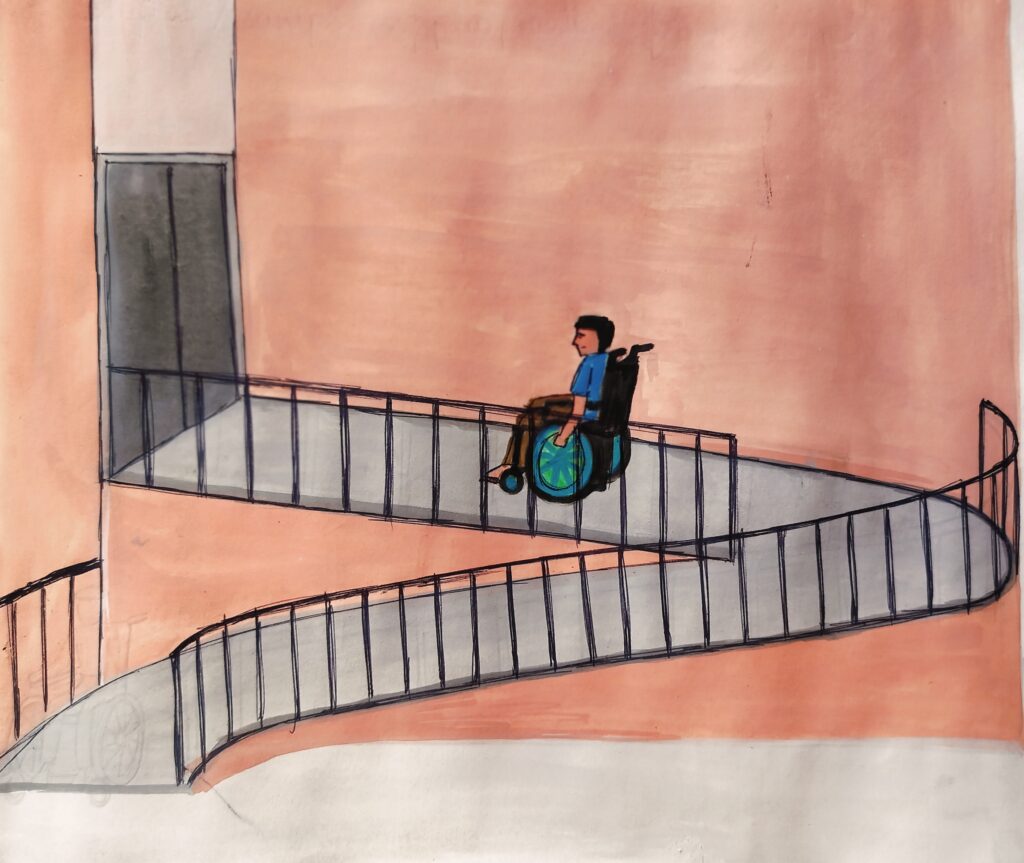
Toilets and Washrooms : Separate for boys & girls, with clear signage and adapted toilets for the smaller children are strongly recommended.
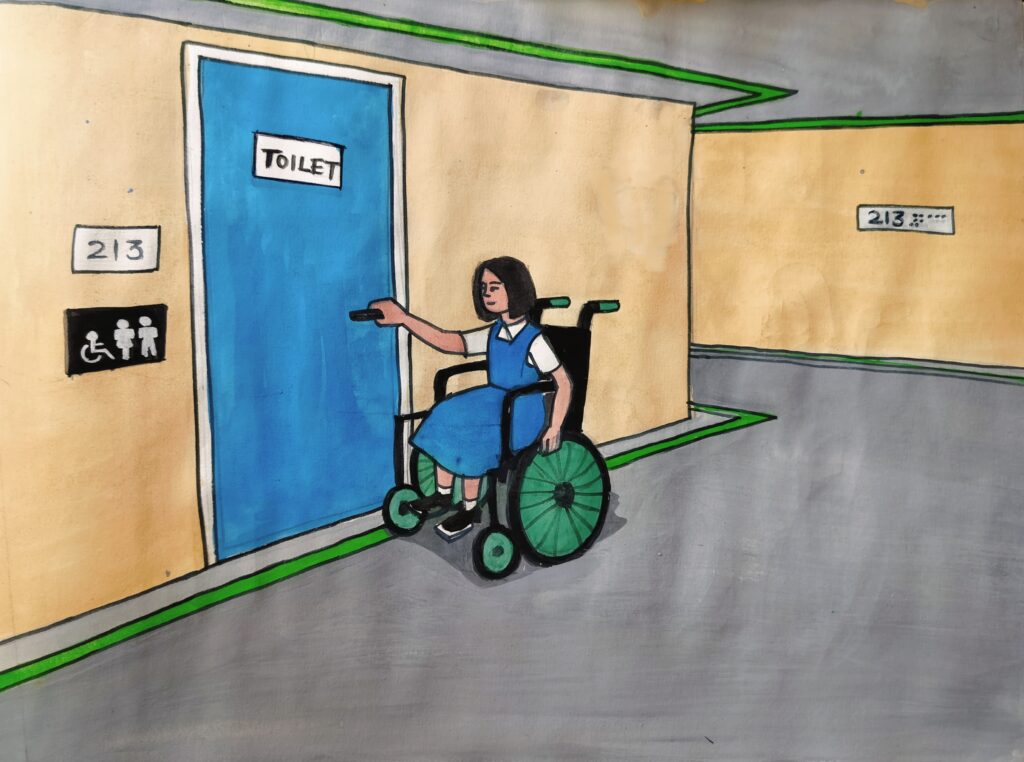
It is important to have,
- Accessible stalls with grab bars (as specified in the CBSE circular)
- Emergency call buttons
- Braille signage and non-slip flooring

Administrative and Reception Areas are the first places visited by any person entering a school. For persons with disabilities and parents of CWSN, such visits may be ridden with anxiety. These places need to have,
- A patient & pleasant person to answer queries/ provide information with clarity
- Counters at wheelchair height
- Waiting area with seating facility
- Communication aids for visitors
- Wheelchair lift or manual portable folding ramps.

6.3.3 Recreational and Social Spaces Accessibility

Ensures equal access to non-academic facilities that support well-being and peer interaction.
Sports and Physical Education Areas
- Inclusive sports equipment
- Adapted PE programs
- Accessible sports courts and fields
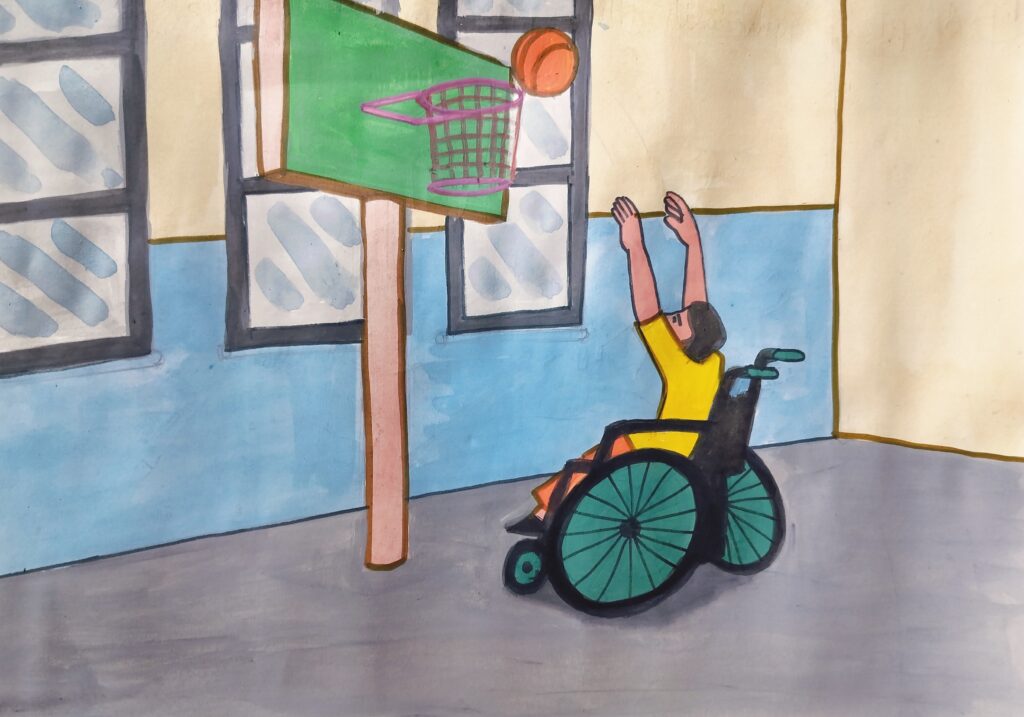
Outdoor Spaces and Playgrounds
- Paved or matted paths for wheelchairs
- Sensory-friendly playground equipment
- Quiet social spaces with seating

Canteens and Library Areas
*Counter height access. *Wide navigation spaces
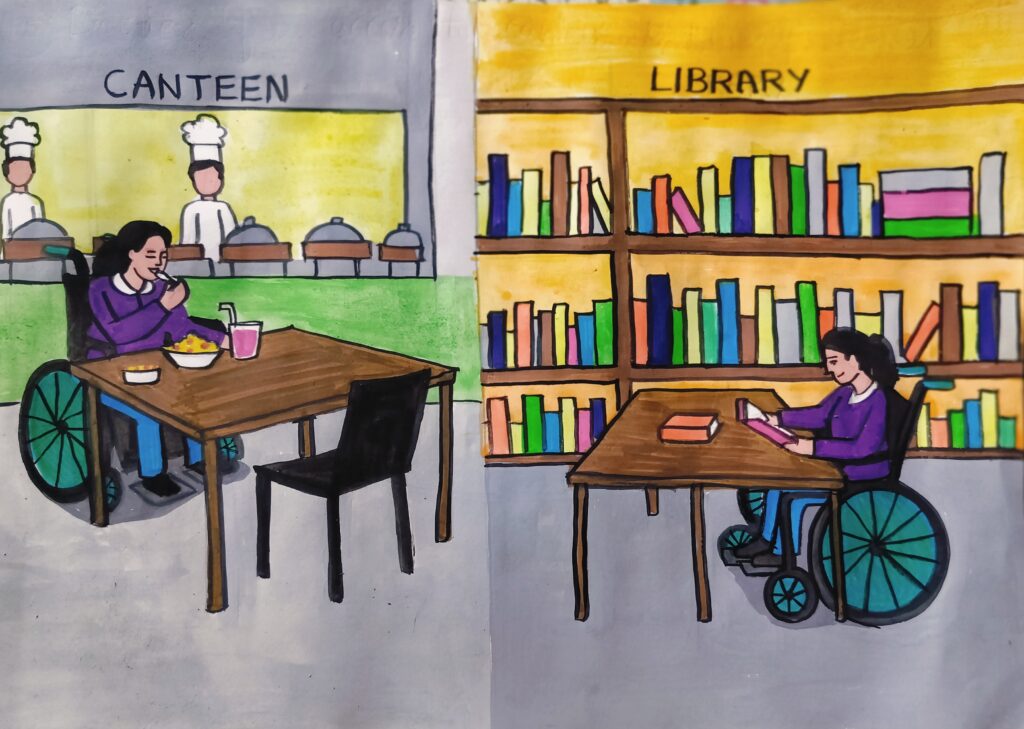
6.3.4 Health, Safety & Support Services Accessibility
Addresses facilities related to medical care, emergencies, and inclusion support for CWSN.
Medical and Counselling Rooms
- Space for stretchers or wheelchairs
- Adjustable exam beds
- Emergency alert systems
Emergency Evacuation
- Audio and visual alarms
- Accessible exits and evacuation chairs
- Personal Emergency Evacuation Plans (PEEPs)
- Inclusion Support Rooms
These may include therapy rooms, medical care rooms and spaces for group activities
Resource room

Sensory room/Calming room
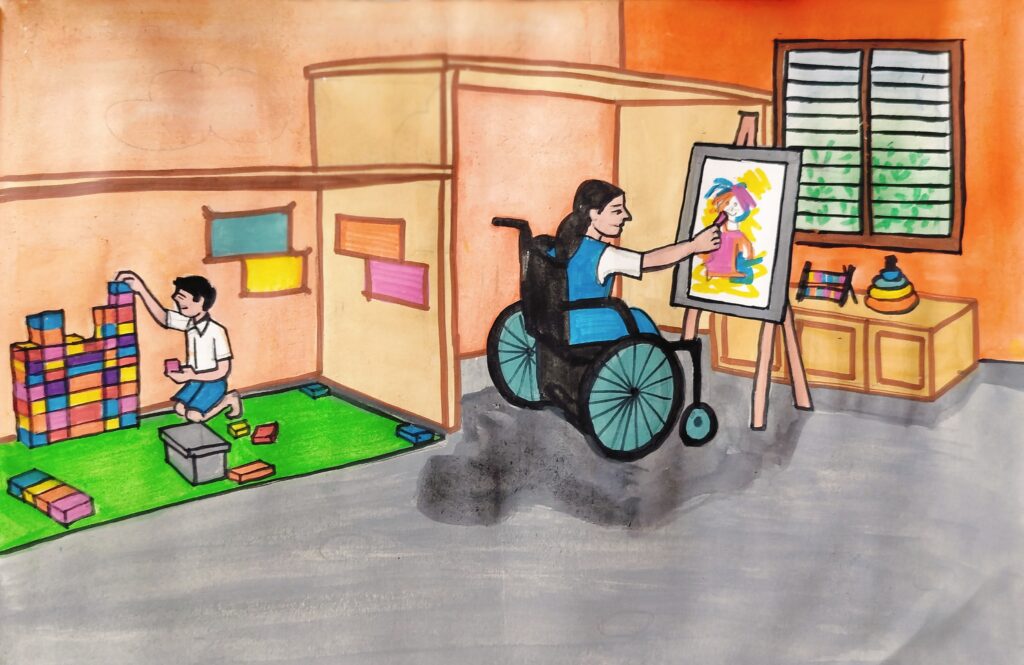
6.3.5 Transportation Accessibility
Includes travel to/from school and on-campus mobility.
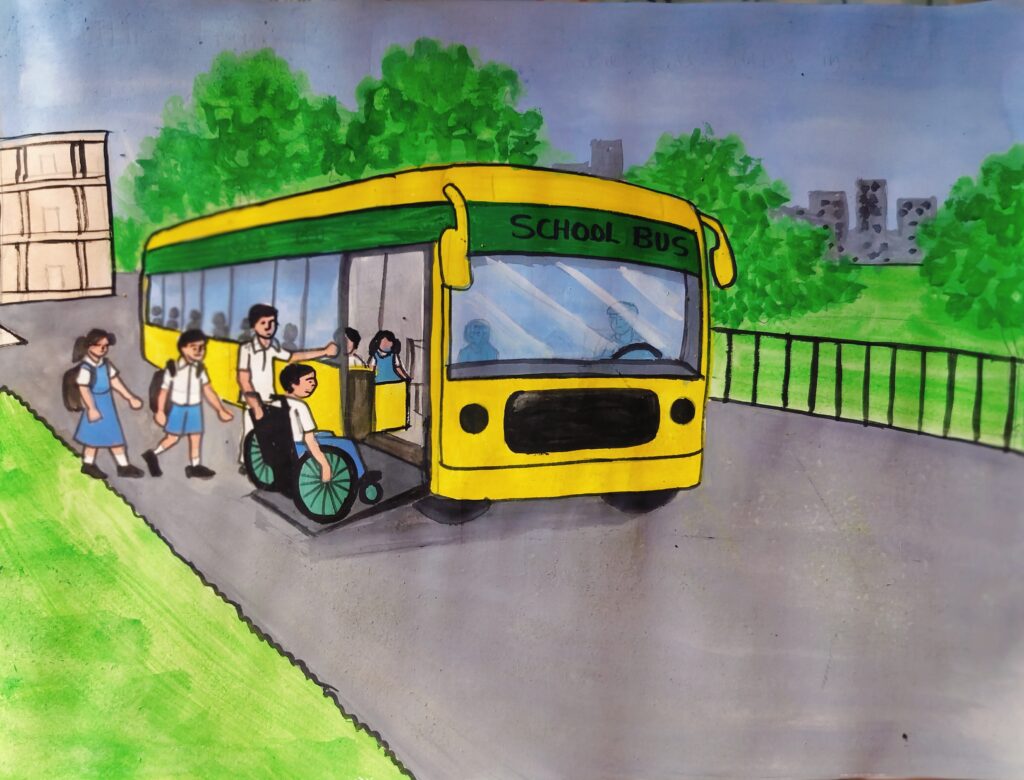
Children may use school transport from home to school and back, within the school campus or from school to other places.
Children may use school transport from home to school and back, within the school campus or from school to other places.
- Colour contrast on vehicle steps and railing.
- Special seat belts for wheelchair users.
- Seat belts (or other restraint systems) for other children with disabilities.
- Handrails.
- Wide doors and steps.
- Special priority seating near the front of a bus.
- Audio-visual announcement of stops.
- Padding on hard surfaces and seat edges
- Bold & prominent signs indicating Bus numbers/ routes
- Route planning to suit health needs (e.g. diabetes)

6.3.6 Communication & Information Accessibility
Covers how information is conveyed and accessed by all students and stakeholders. An effective and smooth information and communication system plays a major role in making a school barrier free and accessible. This system includes anything and everything that is conveyed to or exchanged amongst all the stakeholders in the school. The communication may be through audio, visual, tactile, verbal, non-verbal or digital means.
▪ Signage and Wayfinding
- High-contrast, Braille, and raised-text signs
- Clear directional signage at key points
- Adequate lighting and strategic placement
▪ Digital and Printed Communications
- Accessible websites and school apps
- Multiple communication formats (audio, visual, tactile)
- Inclusive announcements, notices, and circulars.
6.4 Policy and Legal Compliance Framework for Accessibility in Schools
- CBSE Circular No.05/2023 and Affiliation Byelaws
- RPWD Act 2016 compliance
- NEP 2020 alignment
- Stakeholder responsibility and planning
| S.NO | Framework/Policy | Key Focus | Requirements/Provisions | Implications for Schools |
| 1 | CBSE circular No. 05/2023 with Affiliation byelaws 2018 | Infrastructure & Inclusion | – Rule 4.7.3: Ramps, accessible toilets, lifts, etc. – Rule 14.5.2: Inclusion of Students with special needs. | Mandatory for all CBSE schools to provide accessible infrastructure and promote inclusive practices |
| 2 | RPWD Act, 2016 (Rights of Persons with Disabilities) | Legal rights & equal opportunities | – Section 16: Inclusive education, reasonable accommodations – Section 25: Non-discrimination in access and support – Mandatory accessibility in buildings, resources, and communication | Schools must ensure accessible infrastructure, curriculum, and learning materials; Legal accountability for non-compliance |
| 3 | NEP2020 (National Education Policy) | Inclusive and equitable education | – Emphasizes Universal Design for Learning (UDL) – Inclusive teaching practices, curriculum, assessments – Priority support for vulnerable groups | Schools must adopt flexible, inclusive pedagogy and accessible curriculum; build teacher capacity for inclusive education |
| 4 | Stakeholder Responsibility & Planning | Collaborative implementation | – Admin: must ensure that infrastructure, budget, staffing and policies are in place. -Teachers- Inclusive teaching & classroom adaptation. -Parents- Engage in planning and feedback. -Students- Peer support & empathy building. | All stakeholders must be actively involved in planning, executing, and monitoring inclusive education strategies |
6.5 Barrier-free access goes beyond physical infrastructure CASE STUDIES- Stories of Suresh and Maya
CASE STUDY -1
Suresh is a 6-year-old child with severe autism and behavioural disorders who just started attending the local inclusive school. To ensure that Suresh can access all activities and curriculum and reach his potential, his school team focused on the following adaptations: predictability, communication support, sensory regulation, behaviour support and structured learning. Here are some examples of adaptations that helped Suresh learn and make appropriate academic progress:
- Visual support.
- Picture schedules.
- Short and clear instructions.
- Breaking down assignments into small manageable parts with visual cues.
- Repetition and routine.
- Calm down corners with calming items such as fidget tools, weighted vests.
- Social stories constructed to teach him socially appropriate behaviour.
- Minimizing sensory overload by reducing noise levels and using soft lights.
- Predictable classroom layout with clearly labelled and structured areas.
- Usage of Picture exchange system (PECS) for communication.
- Providing him extra time to process and respond when interacting with the teacher.
- Reduced workload.
- Option to respond by pointing instead of writing.
- Offering frequent short breaks throughout his school day.
With these support services, Suresh’s communication and social skills significantly improved and inappropriate behaviours reduced in frequency and intensity.
CASE STUDY -2
Maya is a five-year-old who entered Sr.KG with a strong curiosity and age-appropriate cognitive skills. Her parents reported she enjoyed books and could identify letters and numbers at home. They did not mention any other difficulty Maya exhibited.
However, within weeks of school beginning, her teacher noted:
- Maya seemed “unfocused” and “didn’t follow instructions”
- She struggled during group activities and rarely participated
- She often played alone and appeared withdrawn
- Her speech was sometimes unclear to classmates
These signs and observations revealed that Maya had problems with hearing and speech. But neither the school nor the parents took timely steps to intervene or accommodate her hearing loss. This was more due to lack of awareness and right guidance. Even Maya’s teacher was not trained in hearing-related classroom strategies.
As a consequence, by mid-year, Maya’s academic performance declined; she failed to master foundational literacy skills; she became frustrated and began showing behavioural outbursts. Socially, she experienced increasing isolation and she stopped attempting to communicate with classmates.
Maya’s parents were deeply concerned for Maya started hating school. Eventually, the parents agreed with the school to get her assessments done and came back with the reports to discuss the next step forward. But what was lost by then, was precious time and the socio-emotional health of the child and the family.
What could have been done in school?
- Timely intervention and Right guidance to the parents.
- Provided some basic and critical supports like, hearing aids; placement near teacher or board; instruction with gestures, picture or written cues and language support through speech therapy.
- Training for teachers to teach Maya the way she can learn and peer training for the others to communicate with Maya.
| Source and Attribution of images All images used in the above Assets and Aids are originally created. |
| This digital material has been developed by the Sri Sathya Sai Vidya Vahini Inclusive Education Project, a unit of Sri Sathya Sai Central Trust, Prasanthi Nilayam, as a collaborative offering in the service of our nation. |